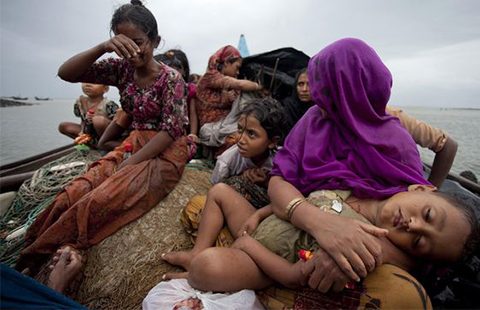ASEAN needs to break its own rules when it comes to crises like the Rohingya boat people.
What can be done about the Rohingya?
Unwanted by Myanmar, marginalised in Bangladesh, set adrift on the Andaman Sea: almost nobody is rushing to offer assistance. The mistreatment of the Rohingya is a regional scandal and it will only be fixed with a multi-faceted regional response. Resolving this decades-long humanitarian crisis requires more interest and resources from across the Southeast Asian region.
Every year that region weathers criticism for its adherence to the idea of non-intervention in the internal affairs of Association of Southeast Asian Nations (ASEAN) members. This insistence has provided mutual protection for national elites eager to make sure that their own governments–even when they commit egregious human rights violations–can count on the public support of their neighbors. In a region where democratic government has shallow roots it is an authoritarian standard that defines ASEAN solidarity. Critics therefore find many reasons to lash the bloc for its tolerance of messy humanitarian and conflict situations within ASEAN’s borders.
Non-interference certainly limits the effectiveness of the grouping, especially during times of acute public interest in troubling domestic political situations. Earlier in the year stranded boats in the Andaman Sea, over-loaded with Rohingya and some Bangladeshis, led many to once again question the value of this core ASEAN principle. When taken alongside the notions of sovereignty, territorial integrity and national identity that also form part of the Treaty of Amity and Cooperation in Southeast Asia, it makes sense that ASEAN has developed a reputation for indulging the domestic political fancies of its members.
Yet that should not matter for ASEAN. In the case of the Rohingya there is good reason for ASEAN to be breaking its own rules, at least in a modest fashion.
The bloc could seek to develop a fully-fledged fact-finding and analytical capacity that would support Myanmar’s own efforts to get to grips with crafting a long-term solution. Advisors on political, cultural and economic topics from elsewhere in ASEAN could probably be trusted to work in Myanmar’s best interests, while also seeking to ameliorate the region’s concerns about this festering crisis. Even after all of the discussion about the Rohingya in 2015 there is clearly no regional solution; not even a road map towards building the right kinds of frameworks to tackle these longstanding problems.
ASEAN is therefore missing an opportunity to take leadership and to show the rest of the world that its model of inclusion and solidarity can work with even the most complex political and humanitarian conundrums. There is no sense in which other models are necessarily better; indeed ASEAN enjoys an enviable track record of avoiding major conflicts between its member states. It is this track record that now needs to be put to use in the management of local-level difficulties, like those facing the Rohingya.
Such problems will always be harder and more sensitive, but they are the ones that have the potential to destabilise and discredit what is otherwise one of the world’s most dynamic regions.
This is an extract from an essay first written for the inaugural edition of the Habibie Center’s new monthly publication, Thinking ASEAN. Read the full article, and others, here.
Nicholas Farrelly is co-founder of New Mandala and director of the ANU Myanmar Research Centre.
 Facebook
Facebook  Twitter
Twitter  Soundcloud
Soundcloud  Youtube
Youtube  Rss
Rss 